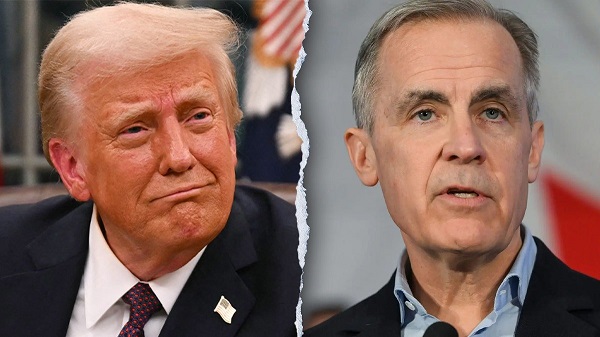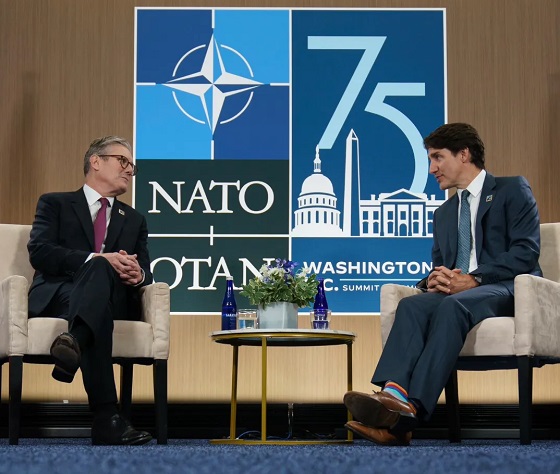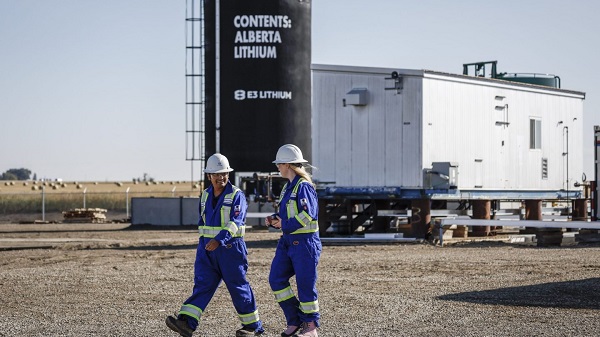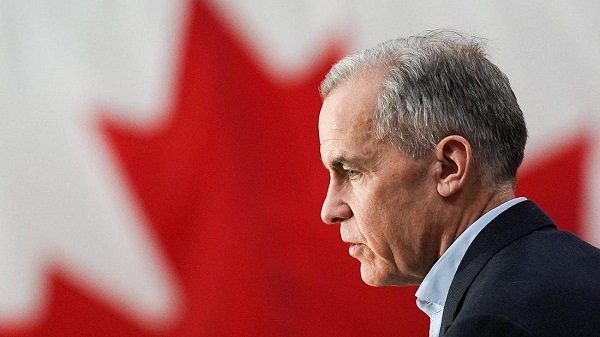Business
Canada’s Real Estate Economy, Fueled by Mass Immigration and Offshore Cash, Is Unsustainable, Mayor Brad West Warns

Port Coquitlam Mayor Brad West meets with U.S. Secretary of State Antony Blinken in 2023 to discuss American concerns over fentanyl trafficking and money laundering tied to transnational crime groups operating in British Columbia.
“Billions upon billions” poured into land speculation have turned B.C. housing into a magnet for global money and mass migration, Mayor Brad West writes in an exclusive Op-Ed for The Bureau.
By Brad West
British Columbia, and much of the country, is confronting the consequences of an economic model that was never built to last. For years, we have been told a comforting story about growth — that as long as cranes dot the skyline and property values climb, prosperity will follow. But beneath that veneer lies a stark truth: our economy is not driven by value-added manufacturing, groundbreaking technology, innovation, or by unlocking our vast natural resource potential. It is built almost entirely on real estate and relentless population growth driven by mass immigration. And it relies on the building and selling of homes to the next wave of newcomers.
This is not diversification. This is dependency. And like all dependencies, it eventually demands a price.
In the not-too-distant past, B.C.’s prosperity came from sectors that created enduring value: forestry and mining that supplied the world; fisheries that sustained communities; manufacturing that turned raw materials into products; and, in more recent years, tech companies that could compete globally.
Today, those industries are shadows of their former selves in our economic mix — thanks, in part, to the strangulation of over-regulation and inordinately lengthy approval processes easily weaponized by those ideologically opposed to resource extraction. Their demise is not a naturally occurring phenomenon — and it is reversible — but it reflects the agenda and decisions of policymakers. In their place, real estate has become the dominant force, representing nearly 30 percent of B.C.’s GDP with its ancillary sectors. That’s a hell of a lot of eggs in a single basket, and the province’s balance sheet has become frighteningly tied to this cycle.
As the government oversaw this reorganization of the economy, it sent out the proverbial bat signal that investment capital didn’t belong in business development, but in land. Message received. Billions upon billions poured into bidding up land prices. Among the many consequences of this misallocation of capital are high land values squeezing out industrial employers and gnawing away at industrial land, weakening our capacity to make and export things. Today, industrial land makes up barely 4 percent of Metro Vancouver’s landmass.
Mass Immigration as Fuel for the Model
This new growth machine runs on people — specifically, the rapid influx of newcomers. In theory, immigration is a tool to strengthen an economy, replenish a workforce, and foster innovation. But in practice, B.C. and Canada have relied on it as the primary fuel for real estate demand. In 2023 alone, Canada added 1.27 million people — the most in 66 years, and almost entirely through immigration. No other G7 country comes close.
The country’s notorious Temporary Foreign Worker Program and unprecedented number of international students have figured prominently in this surge. Programs once intended to fill specific gaps or foster academic exchange have morphed into de facto population pipelines.
It’s all about feeding the beast: bring in more people than the market can comfortably absorb, then build and sell homes to meet the stimulated demand. Rising prices are framed as a sign of economic health, when in reality, they are a sign of scarcity and strain. In B.C., the government has clung to this model by throwing community planning out the window with legislation that overrides local decision-making and forces blanket upzoning without regard for infrastructure capacity or livability.
But all the smoke and mirrors in the world can’t obscure the reality. Hospital emergency rooms close not sporadically, but routinely. More and more students are educated in portables rather than properly resourced schools. Infrastructure — from roads and public transit to sewers and utilities — is under immense strain. It was never designed for the pace of expansion we’ve seen, and the costs of playing catch-up are staggering.
And still the cycle continues — because without that constant flow of new buyers, the whole structure starts to wobble. And wobbling it is.
Ponzi Economics: Why B.C.’s Housing Foundations Are Failing
To call this a Ponzi scheme is not to say it is literally fraudulent in the legal sense. But the comparison is apt: returns for current “investors” depend on recruiting new participants at ever-higher prices. The moment the influx slows, the math stops working.
We’ve seen this movie before. Jurisdictions from Ireland before the 2008 crash, to parts of Spain’s coastal boom towns, to U.S. “Sun Belt” cities in the lead-up to the subprime meltdown — all rode a similar wave. And when it broke, the fallout was severe: construction job losses, collapsing home values, public finances in crisis, and a wave of personal bankruptcies.
In B.C., the warning lights are already flashing. Housing sales have cooled. Developers are shelving projects. Construction employment, once a driver of job growth, is faltering. Debt loads — both personal and governmental — are dangerously high. In the case of the Government of British Columbia, that would be a historic $133 billion. Youth unemployment in the province reached 14.6 percent in July — the highest level since September 2010.
Meanwhile, the sectors that could cushion a downturn — manufacturing, technology, value-added resource development — suffer from the province’s unilateral disarmament.
Let’s be honest: status quo politicians have taken us too far down this road to turn back without consequence. The damage is already being felt — and more is coming. But that doesn’t mean we can stay the course. We must act deliberately, and with purpose, to shift away from an economic model where our primary export is real estate, toward one where we build and produce the goods, technology, and services the world actually needs.
The turnaround won’t be easy, and it won’t be quick. But the longer we wait, the higher the cost of inaction. That means unshackling our resource sectors from endless regulatory gridlock so they can innovate and compete. It means investing in productivity-enhancing infrastructure, research and development, and the skills of our own workforce. And it means having an honest conversation about immigration levels — balancing economic benefits with our capacity to house and integrate new arrivals without fueling a speculative frenzy.
B.C. can either confront these realities now, or wait until the market forces a reckoning upon us. One path allows for a managed, strategic shift toward long-term prosperity. The other leaves us at the mercy of the same “house of cards” economics that has collapsed elsewhere — only this time, we will have no one to blame but ourselves.
Brad West is the Mayor of Port Coquitlam, British Columbia.
Business
Carney’s Bungling of the Tariff Issue Requires a Reset in Canada’s Approach to Trump

Rank and file Americans are best positioned to insist upon a relaxation of Mr. Trump’s tariff policies – that populist base which Mr. Carney neither understands nor respects but whom the President cannot afford to ignore or alienate if he wishes to retain their political support.
By now it is becoming apparent that Mark Carney’s government is seriously bungling Canada’s response to U.S. President Donald Trump’s tariff initiatives. By ill-advisedly imposing counter-tariffs only to withdraw them later, Ottawa temporarily played with “elbows up” – only to learn that, as in hockey, pursuing such a strategy in the absence of a strong offence simply draws penalties and gives the other side a manpower advantage.
As the list of Mr. Carney’s missteps on the tariff file grows – costing Canadians jobs, incomes, and increases in prices – surely it is becoming clear that a fundamental reset is required in Canada’s approach to Mr. Trump and his tariff initiatives if their negative consequences for both Canada and the U.S. are to be overcome.
So what and where is the reset button that could be pushed to redress those initiatives? Who is in the best position to push it, and when is the best opportunity to do so?
That button is not to be found in Washington or on Wall Street, but rather among those to whom Mr. Trump made a promise – time and time again – namely, the American people. “We’re going to get the prices down. We have to get them down. It’s too much. Groceries, cars, everything. We’re going to get the prices down,” he declared repeatedly throughout the 2024 presidential election campaign.
That was the promise. But the current reality is price increases for Americans on food, energy, furniture, and paper products, as well as projected increases in the cost of homes, industrial structures, and public infrastructure as tariffs on steel, aluminum, softwood lumber and timber take their toll. In other words, the reality is not a decrease but an increase in the cost of living for millions of American consumers and voters.
Who then is best positioned to insist upon a relaxation of Mr. Trump’s tariff policies? Not Mr. Carney and his officials, nor even the traditional Washington influencers, but those rank-and-file Americans comprising the massive populist wave that put Mr. Trump in the White House for a second time – that populist base which Mr. Carney neither understands nor respects but whom the President cannot afford to ignore or alienate if he wishes to retain their political support.
So when will be the first real opportunity for Mr. Trump’s core constituency to speak to him effectively – through their votes – about modifying his approach to tariffs? It will be in the months running up to the midterm congressional elections in November, 2026, in which the 435 seats of the House of Representatives and, more crucially, the 35 seats in the US Senate, will be up for election.
Most of those Republican candidates standing for election will want to be pro-Trump to retain hardcore Republican voters, but they will also want to be anti-tariff to secure the support of voters suffering from tariff-induced price increases. How can they be both? By being fully supportive of Mr. Trump’s war on illegal drugs and migrants, bloated bureaucracies, and the mis-management of government finances, while at the same time campaigning as “tariff modifiers”. By asking voters to send them to Washington to support Mr. Trump but to remove the price-increasing-sting of his tariff policies through the negotiation of “reciprocity agreements” with major US trading partners to achieve that objective – just as former president William McKinley, whom Mr. Trump professes to admire, did many years ago.
The election of just a few tariff-moderating Republicans to the U.S. Senate in 2026, to be present when the tariff bill embodying Mr. Trump’s policies eventually gets to that chamber, will do more to improve tariff-disrupting Canada-U.S. trade relations than the ineffectual efforts of those like Mr. Carney who seek to get to Mr. Trump by traditional elite-to-elite negotiating practices.
Getting to Mr. Trump on the tariff issue through his own populist base raises some obvious questions. Which U.S. states, for example, are experiencing the greatest price increases as a result of the tariff wars, and of those, which offer the greatest opportunities to nominate and elect tariff-modifying Republicans to the Senate? Where in the U.S., at the state or national level, are there the beginnings of a grassroots tariff-modification movement, and how might such a movement be encouraged and supported by Canadians as well as Americans.
Americans of course have a vested interest in securing research-informed answers to such questions. But so do Canadians. More on these questions and answers shortly. They are the keys to achieving the desire of the vast majority of rank and file citizens on both sides of the border for a restoration of amicable economic and social relations between our two countries.
Subscribe to Preston’s Substack.
For the full experience, upgrade your subscription.
Business
Labour disputes loom large over Canadian economy

From the Fraser Institute
By Fred McMahon
With labour disputes on the rise, Team Canada faces our greatest economic challenges in decades. It’s a bad look when team members jump the bench for the walk-out/lock-out penalty box—elbows up on the team, not on the ice.
Economic difficulties have escalated in recent years—miserable productivity growth, COVID and its inflation-drenched recovery, the uninvited U.S. trade war, and a government spending spree that left Canada deeply in debt and exacerbated all other difficulties.
Over the same period, labour disputes grew. Hours lost to disputes have been trending down for decades, but up since 2015. For the nine preceding years, the average hours lost annually was 224,000; for the nine years since, it’s been 190,000, but increasing over the years. In 2016, 74,000 hours were lost compared to 362,900 hours in 2023 and 293,600 last year.
Ironically, work stoppages typically occur only if they can wreck havoc on the Canadian economy. They hit sectors where customers and clients have little or no alternative. When customers have choices, they’ll walk away from a shutdown supplier. That encourages workers and businesses to figure out a solution before a strike.
Disputes in transportation and government services are particularly damaging. When Air Canada grounds flights, people and businesses already have tickets and plans. Options are limited and pricey. There is only one Port of Montreal. If it shuts down, there are no other Ports of Montreal. Cargo diversion is, well, limited and pricey. When government employees go on strike, people can’t turn to another government for service.
In 2023 and 2024, Canada suffered 62 transportation such work stoppages, including at the ports of Montreal and Vancouver, Canada’s two largest railways, and the St. Lawrence Seaway.
More disputes are on the way. Canada Post workers recently walked off the job hours after the federal government announced a major move from door-to-door delivery to community mailboxes. In British Columbia, civil servants are on the picket line. Public service unions are preparing to fight efforts to bring federal finances under control. And Air Canada and its flight attendants are now in arbitration after attendants rejected Air Canada’s most recent offer by 99.1 per cent.
As Keith Creel, CEO of Canadian Pacific Kansas City, wrote: “Canada’s message to the world is not one of efficiency, affordability and reliability. Lately, and repeatedly, it’s been the opposite: Disruptions. Delays. Diversions.” This is not a good for Team Canada when Canada needs new investment and entrepreneurship.
Everyone involved in a labour dispute loses. That means Canada losses. Air Canada says its recent strike, three-days long, cost the company $375 million. Employees and customers lose through foregone pay.
More than half a million passengers were directly affected, piling up the losses. Worse is the ripple affect on those not directly affected. When any part of the transportation network is impaired, business and people suffer. The economy is further damaged as investors become skittish about Canadian uncertainty, exacerbating economic difficulties.
Things may get worse. Canada’s economy is shrinking due to the trade war and our own economic mismanagement. That means there’s less stuff to go around. People’s pay on average has to shrink. The economy is not producing enough for everyone to make up “lost wages.” If all wages go up, the economy doesn’t magically start producing more. Instead, money buys less, inflation grows, economic damage intensifies, and there’s even less stuff to go around.
Resentment deepens as workers fight each other over the limited supply of stuff. Those who win make those who lose pay a disproportionate slice of the cost.
Three ways could eliminate or reduce these costs. One is to end unionization in government and essential services. Let the market decide wages. If pay is too low, employees leave for other opportunities, forcing employers to up pay. Another is to incentivize unions to resolve disputes before strikes, for example, by allowing replacement workers. The third is requiring mandatory arbitration, which has an admirable record in Canada of resolving disputes. Legislation should take into account reasonable complaints, whether employers or workers are favoured, and address them.
If Canada’s employers and unions can’t get their act together, only action will avoid dead-loss damage to the Canadian economy, leaving the rest of us as drive-by victims of labour bickering.
-

 Energy18 hours ago
Energy18 hours agoOttawa must eliminate harmful regulations to spur private investment in pipelines
-

 espionage1 day ago
espionage1 day agoStarmer Faces Questions Over Suppressed China Spy Case, Echoing Trudeau’s Beijing Scandals
-

 Alberta2 days ago
Alberta2 days agoJason Kenney’s Separatist Panic Misses the Point
-

 Business19 hours ago
Business19 hours agoLabour disputes loom large over Canadian economy
-

 Energy12 hours ago
Energy12 hours agoBC NDP Premier Opposing a New Oil Pipeline to Tidewater
-

 Business19 hours ago
Business19 hours agoDaily Caller EXCLUSIVE: Chinese Gov’t-Tied Network Training Illegal Immigrants To Drive Big Rigs In US
-

 International12 hours ago
International12 hours agoNegotiations continue in Israel-Hamas peace deal
-

 Automotive2 days ago
Automotive2 days agoBig Auto Wants Your Data. Trump and Congress Aren’t Having It.






